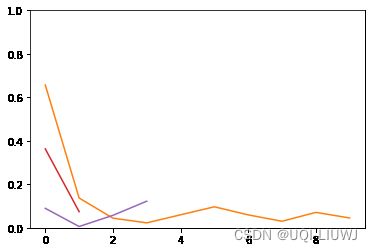pytorch 笔记:使用Tune 进行调参
自动进行调参,我们以pytorch笔记:搭建简易CNN_UQI-LIUWJ的博客-CSDN博客的代码为基础,进行output_channel和learning rate的调参
1 导入库
from functools import partial
import numpy as np
import os
import torch
import torch.nn as nn
import torch.nn.functional as F
import torch.optim as optim
import torchvision
import torch.utils.data as Data
from ray import tune
from ray.tune import CLIReporter
from ray.tune.schedulers import ASHAScheduler
2 超参数(和CNN一致)
EPOCH=1
BATCH_SIZE=50
LR=0.001
DOWNLOAD_MNIST=False
#如果已经事先下载好了 mnist数据,那么DOWNLOAD_MNIST就是False,否则就是True3 数据集&dataloader(和CNN一致)
train_data=torchvision.datasets.MNIST(
root='./mnist/',
#从这个路径找mnist数据/下载mnist数据到这个路径下
train=True,
#这时候数据是训练集(是训练集还是测试集对dropout等会有影响)
transform=torchvision.transforms.ToTensor(),
#将mnist数据集中的数据类型转换为Tensor形式,
download=DOWNLOAD_MNIST)
#生成dataloader
train_loader=Data.DataLoader(
dataset=train_data,
batch_size=BATCH_SIZE,
shuffle=True
)4 模型框架
我们只能调整那些可配置的参数。在这个例子中,我们可以指定第一个卷积层输出的大小为可配置参数。
class CNN(nn.Module):
def __init__(self,channel):
super(CNN,self).__init__()
self.conv1=nn.Sequential(
nn.Conv2d(
in_channels=1,
#输入shape (1,28,28)
out_channels=channel,
########################################################
#输出shape(channel,28,28),channel也是卷积核的数量
#这一行有改动,我们设置channel为外部传入参数
########################################################
kernel_size=5,
stride=1,
padding=2),
#如果想要conv2d出来的图片长宽没有变化,那么当stride=1的时候,padding=(kernel_size-1)/2
nn.ReLU(),
nn.MaxPool2d(kernel_size=2)
#在2*2空间里面下采样,输出shape(16,14,14)
)
self.conv2=nn.Sequential(
nn.Conv2d(
in_channels=channel,
#输入shape (channel,14,14)
#相应地改动
out_channels=32,
#输出shape(32,14,14)
kernel_size=5,
stride=1,
padding=2),
#输出shape(32,7,7),
nn.ReLU(),
nn.MaxPool2d(kernel_size=2)
)
self.fc=nn.Linear(32*7*7,10)
#输出一个十维的东西,表示我每个数字可能性的权重
def forward(self,x):
x=self.conv1(x)
x=self.conv2(x)
x=x.view(x.shape[0],-1)
x=self.fc(x)
return x
5 train函数包装
我们用函数train(config,)来包装训练脚本。config参数将接收我们想要训练的超参数。
def train(config):
cnn=CNN(config['channel'])
###################################################################
#将config中的‘channel’参数用来生成相应的cnn
###################################################################
optimizer=torch.optim.SGD(cnn.parameters(),lr=config['lr'])
###################################################################
#将config中的‘lr’参数作为学习率
###################################################################
loss_func=torch.nn.CrossEntropyLoss()
for epoch in range(10):
for step,(b_x,b_y) in enumerate(train_loader):
output=cnn(b_x)
loss=loss_func(output,b_y)
optimizer.zero_grad()
#清除上一次参数更新的残余梯度
loss.backward()
#损失函数后向传播
optimizer.step()
#参数更新
'''
上面的部分(‘#’之后的部分)和CNN是一样的
'''
with tune.checkpoint_dir(step=epoch) as checkpoint_dir:
path = os.path.join(checkpoint_dir, "checkpoint")
torch.save(
(cnn.state_dict(), optimizer.state_dict()), path)
tune.report(loss=loss.item())
#######################################################################
'''
和ray tune 通信的部分
在这里,我们首先保存一个checkpoint,然后将一些指标反馈给Tune。
Tune可以使用这些指标来决定哪个超参数配置能带来最佳结果。
这些指标也可以用来提前停止性能不好的试验,以避免在这些试验上浪费资源。
checkpoint的保存是可选的。
'''
#######################################################################
print('finish training')
最有趣的部分是与Ray Tune的通信。
6 main函数部分
def main(num_samples=5, max_num_epochs=10):
config = {
"channel": tune.sample_from(lambda _: np.random.randint(2, 31)),
"lr": tune.loguniform(1e-4, 1e-1)
}
#############################################################################
'''
定义各个参数的搜寻空间
tune.sample_from()函数使你有可能定义自己的采样方法来获得超参数。
在每次试验中,Tune现在将从这些搜索空间中随机抽出一个参数组合。
然后,它将并行地训练一些模型,并在这些模型中找到表现最好的一个。
'''
#############################################################################
scheduler = ASHAScheduler(
metric="loss",
mode="min",
max_t=max_num_epochs,
grace_period=1,
reduction_factor=2)
#############################################################################
'''
我们还使用ASHAS调度器,它将提前终止性能不好的试验。[Early stopping]
ASHA 会终止不太有希望的试验,并将更多的时间和资源分配给更有希望的试验。
ASHA 在 Tune 中被记作为“ Trial Scheduler”。
这些 Trial Scheduler 可以提前终止不好的Trial、暂停 Trial、复制 Trial
和更改正在运行的 Trial 的超参数。
'''
#############################################################################
result = tune.run(
partial(train),
config=config,
num_samples=num_samples,
scheduler=scheduler)
#############################################################################
'''
如果用GPU的话,需要在这里声明 resources_per_trial={"cpu": 2, "gpu": gpus_per_trial},
'''
#############################################################################
'''
Tune 将自动在机器或集群上的所有可用内核/GPU 上运行并行试验。
要限制 Tune 使用的内核数量,您可以在 tune.run 之前调用
ray.init(num_cpus=, num_gpus=)。
'''
#############################################################################
best_trial = result.get_best_trial("loss", "min", "last")
print("Best trial config: {}".format(best_trial.config))
print("Best trial final validation loss: {}".format(
best_trial.last_result["loss"])) 7 输出结果(部分)
Number of trials: 5/5 (5 TERMINATED)
Trial name status loc channel lr iter total time (s) loss
DEFAULT_c1831_00000 TERMINATED 127.0.0.1:32068 7 0.00181678 10 329.045 0.0394899
DEFAULT_c1831_00001 TERMINATED 127.0.0.1:18688 27 0.0041803 2 156.015 0.307976
DEFAULT_c1831_00002 TERMINATED 127.0.0.1:33904 23 0.000352946 1 66.1122 2.18557
DEFAULT_c1831_00003 TERMINATED 127.0.0.1:5776 18 0.0326092 10 534.814 0.100436
DEFAULT_c1831_00004 TERMINATED 127.0.0.1:12020 19 0.0783009 10 538.282 0.00954399
2022-03-08 00:33:07,119 INFO tune.py:636 -- Total run time: 650.41 seconds (643.75 seconds for the tuning loop).
Best trial config: {'channel': 19, 'lr': 0.0783008707603346}
Best trial final validation loss: 0.0095439925789833077.1可视化结果:
(要可视化的话,main函数里面的result需要设置为global)
import matplotlib.pyplot as plt
for d in result.trial_dataframes.values():
plt.plot(d.loss)
print(d.loss)
plt.ylim([0,1])
plt.show()可以看到有一些是提前结束了(不好的trail)
7.2 获得最好的一组超参数
result.get_best_config('loss',mode='min')
#{'channel': 6, 'lr': 0.0072715026072560866}